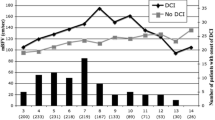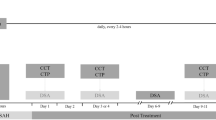Abstract
Background
Aortic coarctation (AC) rarely remains undiagnosed until adulthood. Intracranial aneurysms and spontaneous subarachnoid hemorrhage (SAH) are more frequent in patients with AC than in the general population.
Methods
The purpose of this report is to describe the management of a poor grade SAH patient with previously undiagnosed AC using advanced monitoring techniques of the brain and the cardiovascular system.
Results
A 28-year-old man with previously unknown AC was admitted with aneurysmal SAH WFNS grade 5. Head computed tomography demonstrated thick blood filling the basal cisterns, mild hydrocephalus, and global cerebral edema. The ruptured aneurysm of the anterior communicating artery was successfully coiled on the same day. Echocardiography revealed high grade isthmus stenosis with a pressure gradient of 60 mm Hg. Hospital course was complicated by prerenal failure and severe vasospasm. Neuromonitoring data (cerebral metabolism, brain tissue oxygenation, cerebral blood flow and intracranial pressure) were used as endpoint to define the optimal blood pressure to meet the cerebral metabolic and oxygen demand in each phase.
Conclusions
Cerebral aneurysm rupture associated with coarctation of the aorta is rare. The aim of this report is to call attention to AC in, particularly, young patients presenting with SAH and to discuss advanced multimodal neuromonitoring techniques used to optimize intensive care management.


Similar content being viewed by others
References
Serizawa T, Satoh A, Miyata A, Kobayashi S, Odaki M, Nakamura H, Watanabe Y. Ruptured cerebral aneurysm associated with coarctation of the aorta—report of two cases. Neurol Med Chir (Tokyo). 1992;32:342–5.
Orsi P, Rosa G, Liberatori G, Lunardi PP, Ferrante L. Repair of two unruptured intracranial aneurysms in the presence of coarctation of the aorta-anesthetic implications and management. J Neurosurg Anesthesiol. 1993;5:48–51.
Fukuda H, Sako K, Yonemasu Y. Coarctation of the descending aorta with aneurysm of the anterior communicating artery. Surg Neurol. 1985;23:380–2.
Reifenstein GH, Levine SA, Gross RE. Coarctation of the aorta; a review of 104 autopsied cases of the adult type, 2 years of age or older. Am Heart J. 1947;33:146–68.
Mercado R, Lopez S, Cantu C, Sanchez A, Revuelta R, Gomez-Llata S, Bouffard JA, Pineda C. Intracranial aneurysms associated with unsuspected aortic coarctation. J Neurosurg. 2002;97:1221–5.
Kirby ML, Waldo KL. Role of neural crest in congenital heart disease. Circulation. 1990;82:332–40.
Tseng MY, Hutchinson PJ, Richards HK, Czosnyka M, Pickard JD, Erber WN, Brown S, Kirkpatrick PJ. Acute systemic erythropoietin therapy to reduce delayed ischemic deficits following aneurysmal subarachnoid hemorrhage: a phase ii randomized, double-blind, placebo-controlled trial. Clinical article. J Neurosurg. 2009;111:171–80.
Wartenberg KE, Schmidt JM, Claassen J, Temes RE, Frontera JA, Ostapkovich N, Parra A, Connolly ES, Mayer SA. Impact of medical complications on outcome after subarachnoid hemorrhage. Crit Care Med. 2006;34:617–23. quiz 624.
Hillered L, Vespa PM, Hovda DA. Translational neurochemical research in acute human brain injury: the current status and potential future for cerebral microdialysis. J Neurotrauma. 2005;22:3–41.
Stehbens WE. Cerebral aneurysms and congenital abnormalities. Australas Ann Med. 1962;11:102–12.
Robertson CS, Gopinath SP, Uzura M, Valadka AB, Goodman JC. Metabolic changes in the brain during transient ischemia measured with microdialysis. Neurol Res. 1998;20(Suppl 1):S91–4.
Helbok R, Madineni RC, Schmidt JM, Kurtz P, Fernandez L, Ko SB, Choi A, Stuart RM, Connolly ES, Lee K, Badjatia N, Mayer SA, Claassen J. Intracerebral monitoring of silent infarcts after subarachnoid hemorrhage. Neurocrit Care. 2010 [Epub ahead of print].
Oddo M, Schmidt JM, Carrera E, Badjatia N, Connolly ES, Presciutti M, Ostapkovich ND, Levine JM, Le Roux P, Mayer SA. Impact of tight glycemic control on cerebral glucose metabolism after severe brain injury: a microdialysis study. Crit Care Med. 2008;36:3233–8.
Vespa P, Boonyaputthikul R, McArthur DL, Miller C, Etchepare M, Bergsneider M, Glenn T, Martin N, Hovda D. Intensive insulin therapy reduces microdialysis glucose values without altering glucose utilization or improving the lactate/pyruvate ratio after traumatic brain injury. Crit Care Med. 2006;34:850–6.
Helbok R, Schmidt JM, Kurtz P, Hanafy KA, Fernandez L, Stuart RM, Presciutti M, Ostapkovich ND, Connolly ES, Lee K, Badjatia N, Mayer SA, Claassen J. Systemic glucose and brain energy metabolism after subarachnoid hemorrhage. Neurocrit Care. 2010;12:317–23.
Author information
Authors and Affiliations
Corresponding author
Rights and permissions
About this article
Cite this article
Helbok, R., Beer, R., Chemelli, A. et al. Multimodal Neuromonitoring in a Patient with Aneurysmal Subarachnoid Hemorrhage Associated with Aortic Coarctation. Neurocrit Care 14, 433–437 (2011). https://doi.org/10.1007/s12028-011-9503-1
Published:
Issue Date:
DOI: https://doi.org/10.1007/s12028-011-9503-1




